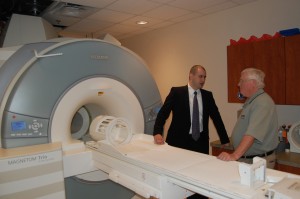A cancer imaging agent that was originally developed at Emory was approved on Friday, May 27 by the U.S. Food and Drug Administration.
Axumin, a PET (positron emission tomography) imaging agent, is indicated for diagnosis of recurrent prostate cancer in men who have elevated PSA levels after previous treatment. Axumin, now being commercialized by UK-based Blue Earth Diagnostics, is also known as 18F-fluciclovine or FACBC (an abbreviation for anti-1-amino-3-[18F]fluorocyclobutane-1- carboxylic acid).
Imaging using axumin/fluciclovine is expected to help doctors detect and localize recurrent prostate cancer, and could guide biopsy or the planning of additional treatment. Fluciclovine was originally developed at Emory by Mark Goodman and Timothy Shoup, who is now at Massachusetts General Hospital.
The earliest research on fluciclovine in the 1990s was on its use for imaging brain tumors, and it received a FDA “orphan drug” designation for the diagnosis of glioma in 2015. About a decade ago, Emory researchers stumbled upon fluciclovine’s utility with prostate cancer, while investigating its activity in a patient who appeared to have renal cancer, according to radiologist David Schuster, who has led several clinical studies testing fluciclovine.
“This led us to see if this radiotracer would be good for looking at prostate cancer, specifically because of its low native urinary excretion,” Schuster is quoted as saying in the radiology newsletter Aunt Minnie. “If you look at the history of medical science, it is taking advantage of the unexpected.”
Early research on the probe was supported by Nihon Mediphysics, and later support for clinical research on FACBC/fluciclovine came from the National Cancer Institute, the Georgia Research Alliance and the Georgia Cancer Coalition. [Both Emory and Goodman are eligible to receive royalties from its commercialization]. Additional information here.
References for two completed studies on fluciclovine in recurrent prostate cancer
Odewole OA et al. Comparison with CT imaging (2016)
Schuster DM et al. Head to head comparison with ProstaScint (2014). Read more






